View in other NatureServe Network Field Guides
NatureServe
Montana
Utah
Wyoming
Idaho
Wisconsin
British Columbia
South Carolina
Yukon
California
New York
Eastern Fox Squirrel - Sciurus niger
State Rank Reason (see State Rank above)
Within it's native range, the species is common to uncommon in deciduous woodlands. It appears to be stable and faces threats from clearing of riparian forest.
General Description
A large squirrel that is highly variable in color, both individually and geographically. Over most of the range, the pelage is rusty yellowish with a pale yellow to orange (or light gray to dirty white) belly and a bushy tail bordered with fulvous-tipped hairs. In the Southeast, body may be sprinkled with yellow, white, and black, with the head mostly blackish except for the whitish nose and ears. In the vicinity of the Delmarva Peninsula, color may be pure steel-gray with no fulvous (Burt and Grossenheider 1964). Melanism is not uncommon. For adults, total length is 454 to 698 mm, tail length is 200 to 330 mm, and hind foot length is 51 to 82 mm (Hall 1981). Mass is 696 to 1361 g, with an average of about 800 g. There is a total of 20 teeth. The bones fluoresce bright red under longwave ultraviolet light (unique among normal adult mammals) (Flyger and Gates 1982). The Eastern Fox Squirrel of the southeastern Coastal Plain of North America is the largest tree squirrel in the western hemisphere. (Weigl et al. 1989) reported an average mass of 1006 g in North Carolina and 962 g for 44 specimens collected in the Carolinas and northern Georgia. Western Fox Squirrels tend to be smaller (600 to 900+ g).
Diagnostic Characteristics
Larger than Sciurus carolinensis, in which adults are 383 to 525 mm in total length and 340 to 700 g; also, S. niger has four cheek teeth on each side of the upper jaw (S. carolinensis usually has five), and in S. niger the tail hairs generally are not tipped with white (Flyger and Gates 1982).
Species Range
Montana Range
Range Descriptions
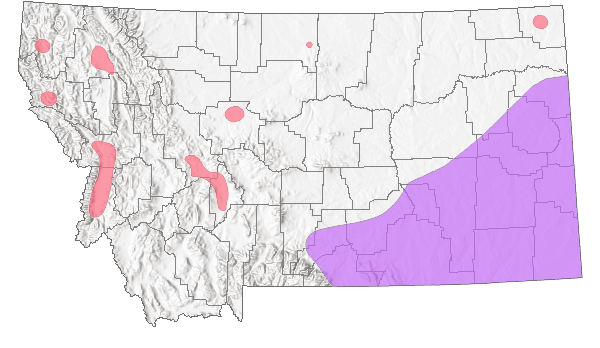 Western Hemisphere Range
Western Hemisphere Range
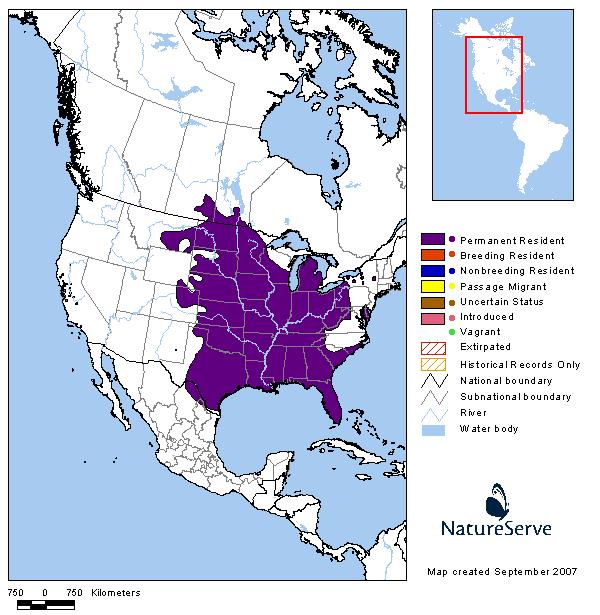
Observations in Montana Natural Heritage Program Database
Number of Observations: 349
(Click on the following maps and charts to see full sized version)
Map Help and Descriptions
Relative Density

Recency
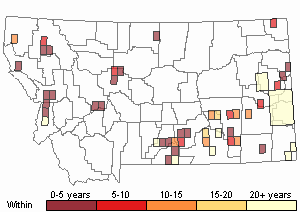

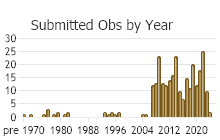
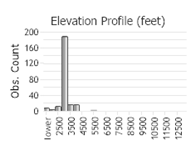 (Observations spanning multiple months or years are excluded from time charts)
(Observations spanning multiple months or years are excluded from time charts)
Migration
Non-migratory.
Habitat
Riparian cottonwood forests. Riparian stands of box elder, green ash, plains cottonwood, and willow and town parks. More prone to open forests than S. carolinensis.
Ecological Systems Associated with this Species
- Details on Creation and Suggested Uses and Limitations
How Associations Were Made
We associated the use and habitat quality (common or occasional) of each of the 82 ecological systems mapped in Montana for
vertebrate animal species that regularly breed, overwinter, or migrate through the state by:
- Using personal observations and reviewing literature that summarize the breeding, overwintering, or migratory habitat requirements of each species (Dobkin 1992, Hart et al. 1998, Hutto and Young 1999, Maxell 2000, Foresman 2012, Adams 2003, and Werner et al. 2004);
- Evaluating structural characteristics and distribution of each ecological system relative to the species' range and habitat requirements;
- Examining the observation records for each species in the state-wide point observation database associated with each ecological system;
- Calculating the percentage of observations associated with each ecological system relative to the percent of Montana covered by each ecological system to get a measure of "observations versus availability of habitat".
Species that breed in Montana were only evaluated for breeding habitat use, species that only overwinter in Montana were only evaluated for overwintering habitat use, and species that only migrate through Montana were only evaluated for migratory habitat use.
In general, species were listed as associated with an ecological system if structural characteristics of used habitat documented in the literature were present in the ecological system or large numbers of point observations were associated with the ecological system.
However, species were not listed as associated with an ecological system if there was no support in the literature for use of structural characteristics in an ecological system,
even if point observations were associated with that system.
Common versus occasional association with an ecological system was assigned based on the degree to which the structural characteristics of an ecological system matched the preferred structural habitat characteristics for each species as represented in scientific literature.
The percentage of observations associated with each ecological system relative to the percent of Montana covered by each ecological system was also used to guide assignment of common versus occasional association.
If you have any questions or comments on species associations with ecological systems, please contact the Montana Natural Heritage Program's Senior Zoologist.
Suggested Uses and Limitations
Species associations with ecological systems should be used to generate potential lists of species that may occupy broader landscapes for the purposes of landscape-level planning.
These potential lists of species should not be used in place of documented occurrences of species (this information can be requested at:
mtnhp.mt.gov/requests) or systematic surveys for species and evaluations of habitat at a local site level by trained biologists.
Users of this information should be aware that the land cover data used to generate species associations is based on imagery from the late 1990s and early 2000s and was only intended to be used at broader landscape scales.
Land cover mapping accuracy is particularly problematic when the systems occur as small patches or where the land cover types have been altered over the past decade.
Thus, particular caution should be used when using the associations in assessments of smaller areas (e.g., evaluations of public land survey sections).
Finally, although a species may be associated with a particular ecological system within its known geographic range, portions of that ecological system may occur outside of the species' known geographic range.
Literature Cited
- Adams, R.A. 2003. Bats of the Rocky Mountain West; natural history, ecology, and conservation. Boulder, CO: University Press of Colorado. 289 p.
- Dobkin, D. S. 1992. Neotropical migrant land birds in the Northern Rockies and Great Plains. USDA Forest Service, Northern Region. Publication No. R1-93-34. Missoula, MT.
- Foresman, K.R. 2012. Mammals of Montana. Second edition. Mountain Press Publishing, Missoula, Montana. 429 pp.
- Hart, M.M., W.A. Williams, P.C. Thornton, K.P. McLaughlin, C.M. Tobalske, B.A. Maxell, D.P. Hendricks, C.R. Peterson, and R.L. Redmond. 1998. Montana atlas of terrestrial vertebrates. Montana Cooperative Wildlife Research Unit, University of Montana, Missoula, MT. 1302 p.
- Hutto, R.L. and J.S. Young. 1999. Habitat relationships of landbirds in the Northern Region, USDA Forest Service, Rocky Mountain Research Station RMRS-GTR-32. 72 p.
- Maxell, B.A. 2000. Management of Montana's amphibians: a review of factors that may present a risk to population viability and accounts on the identification, distribution, taxonomy, habitat use, natural history, and the status and conservation of individual species. Report to U.S. Forest Service Region 1. Missoula, MT: Wildlife Biology Program, University of Montana. 161 p.
- Werner, J.K., B.A. Maxell, P. Hendricks, and D. Flath. 2004. Amphibians and reptiles of Montana. Missoula, MT: Mountain Press Publishing Company. 262 p.
Food Habits
More adaptable than S. carolinensis--nuts, seeds, corn, buds, flowers, tubers, bulbs, roots, arthropods, and birds' eggs. Scatter hoards of fall mast crops in shallow holes.
Ecology
Home ranges may be about 18.5 acres for adult males, 8.75 acres for adult females, 7.5 acres for juveniles, and 37.5 acres for juvenile males. Homerange size and population density determined by habitat quality and food crops.
Reproductive Characteristics
In Montana probably 2 peaks: December to January and April to June. Variable. Young may be born from February to September. Reach sexual maturity in 10 months.
Stewardship Responsibility
References
- Literature Cited AboveLegend:
 View Online Publication
View Online Publication Burt, W.H. and R.P. Grossenheider. 1964. A field guide to the mammals. Houghton Mifflin Co.
Burt, W.H. and R.P. Grossenheider. 1964. A field guide to the mammals. Houghton Mifflin Co. Flyger, V., and J.E. Gates. 1982. Fox and gray squirrels. Pages 209-229 in J. A. Chapman and G. A. Feldhamer, editors. Wild mammals of North America: biology, management, and economics. Johns Hopkins Univ. Press, Baltimore.
Flyger, V., and J.E. Gates. 1982. Fox and gray squirrels. Pages 209-229 in J. A. Chapman and G. A. Feldhamer, editors. Wild mammals of North America: biology, management, and economics. Johns Hopkins Univ. Press, Baltimore. Hall, E.R. 1981. The mammals of North America, volumes I and II. John Wiley & Sons, New York, NY. 1181 pp.
Hall, E.R. 1981. The mammals of North America, volumes I and II. John Wiley & Sons, New York, NY. 1181 pp. Weigl, P.D., M.A. Steele, L.J. Sherman, J.C. Ha and T.S. Sharpe. 1989. The Ecology of the fox squirrel (Sciurus niger) in North Carolina: implications for survival in the Southeast. Tallahassee, Fla: Tall Timbers Research Station.
Weigl, P.D., M.A. Steele, L.J. Sherman, J.C. Ha and T.S. Sharpe. 1989. The Ecology of the fox squirrel (Sciurus niger) in North Carolina: implications for survival in the Southeast. Tallahassee, Fla: Tall Timbers Research Station.
- Additional ReferencesLegend:
 View Online Publication
View Online Publication
Do you know of a citation we're missing? American Gem Corporations. 1996. Application for an Operating Permit and Proposed Plan of Operations: Gem Mountain Sapphire Mine, Granite County, Montana. August 1996
American Gem Corporations. 1996. Application for an Operating Permit and Proposed Plan of Operations: Gem Mountain Sapphire Mine, Granite County, Montana. August 1996 Bauer, Delane, 2002, 2002 Four Seasons Wildlife Study. Savage Mine Report, Richland County, Montana.
Bauer, Delane, 2002, 2002 Four Seasons Wildlife Study. Savage Mine Report, Richland County, Montana. Foresman, K.R. 2001. The wild mammals of Montana. American Society of Mammalogists, Special Publication Number 12. Lawrence, KS. 278 pp.
Foresman, K.R. 2001. The wild mammals of Montana. American Society of Mammalogists, Special Publication Number 12. Lawrence, KS. 278 pp. Foresman, K.R. 2012. Mammals of Montana. Second edition. Mountain Press Publishing, Missoula, Montana. 429 pp.
Foresman, K.R. 2012. Mammals of Montana. Second edition. Mountain Press Publishing, Missoula, Montana. 429 pp. Gniadek, S. 1983. Southwest Glendive Wildlife Baseline Inventory. Miles City, Mont: Bureau of Land Management, Miles City District Office. 56 pp with appendices.
Gniadek, S. 1983. Southwest Glendive Wildlife Baseline Inventory. Miles City, Mont: Bureau of Land Management, Miles City District Office. 56 pp with appendices. Hoffmann, R.S., P.L. Wright, and F.E. Newby. 1969. The distribution of some mammals in Montana. I. Mammals other than bats. Journal of Mammalogy 50(3): 579-604.
Hoffmann, R.S., P.L. Wright, and F.E. Newby. 1969. The distribution of some mammals in Montana. I. Mammals other than bats. Journal of Mammalogy 50(3): 579-604. Joslin, Gayle, and Heidi B. Youmans. 1999. Effects of recreation on Rocky Mountain wildlife: a review for Montana. [Montana]: Montana Chapter of the Wildlife Society.
Joslin, Gayle, and Heidi B. Youmans. 1999. Effects of recreation on Rocky Mountain wildlife: a review for Montana. [Montana]: Montana Chapter of the Wildlife Society. Koprowski, J. L. 1994. Sciurus niger. American Society of Mammalogists, Lawrence, KS. Mammalian Species No. 479:1-9.
Koprowski, J. L. 1994. Sciurus niger. American Society of Mammalogists, Lawrence, KS. Mammalian Species No. 479:1-9. MacCracken, J.G., D.W. Uresk, and R.M. Hansen. 1985. Rodent-vegetation relationships in southeastern Montana. Northwest Science 59:272-278.
MacCracken, J.G., D.W. Uresk, and R.M. Hansen. 1985. Rodent-vegetation relationships in southeastern Montana. Northwest Science 59:272-278. Matthews, W.L. and J.E. Swenson. 1982. The mammals of east-central Montana. Proc. Mont. Acad. Sci. 39: 1-13.
Matthews, W.L. and J.E. Swenson. 1982. The mammals of east-central Montana. Proc. Mont. Acad. Sci. 39: 1-13. Reid, F. 2006. Peterson Field Guide to Mammals of North America, 4th Edition. Houghton Mifflin Company: Boston and New York, 608 pp.
Reid, F. 2006. Peterson Field Guide to Mammals of North America, 4th Edition. Houghton Mifflin Company: Boston and New York, 608 pp. Western Technology and Engineering, Inc. (WESTECH)., 1994, Wildlife Monitoring Absaloka Mine Area Annual Report, 1994. Montana SMP 85005. OSMP Montana 0007D. Febr. 24, 1994.
Western Technology and Engineering, Inc. (WESTECH)., 1994, Wildlife Monitoring Absaloka Mine Area Annual Report, 1994. Montana SMP 85005. OSMP Montana 0007D. Febr. 24, 1994. Western Technology and Engineering, Inc. (WESTECH)., 1996, Wildlife Monitoring Absaloka Mine Area Annual Report, 1995. Montana SMP 85005. OSMP Montana 0007D. Febr. 23, 1996.
Western Technology and Engineering, Inc. (WESTECH)., 1996, Wildlife Monitoring Absaloka Mine Area Annual Report, 1995. Montana SMP 85005. OSMP Montana 0007D. Febr. 23, 1996.
- Web Search Engines for Articles on "Eastern Fox Squirrel"
- Additional Sources of Information Related to "Mammals"





